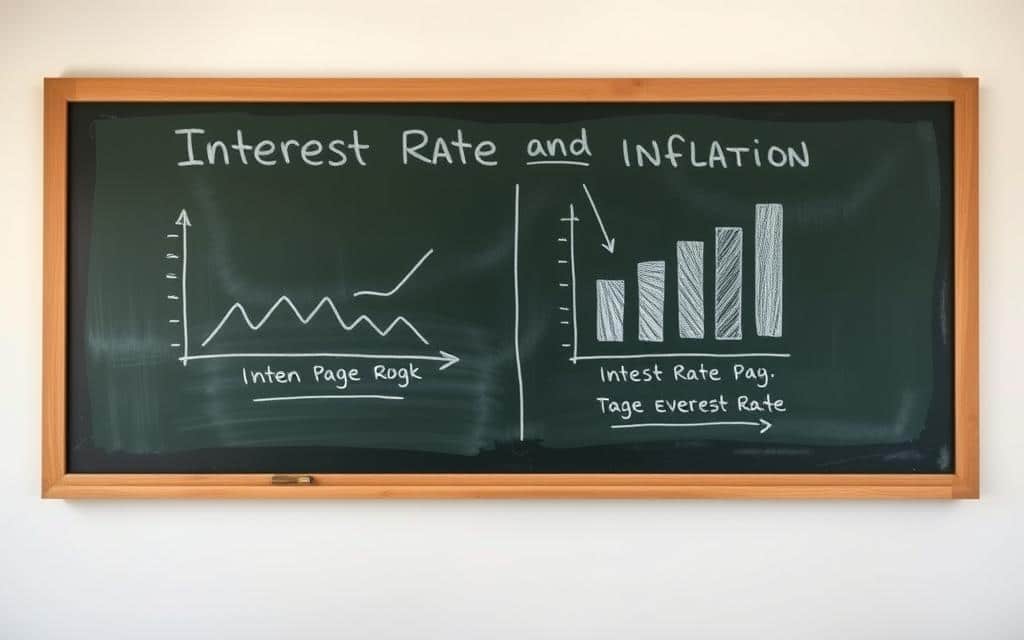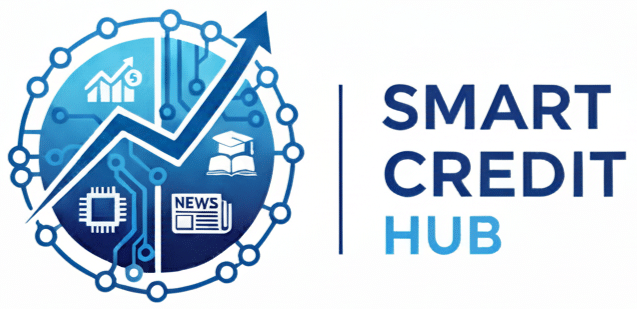Everyone has noticed it – in their wallets, in the news, and when making big financial plans. Changes in the Federal Reserve’s policy rate affect things big and small. From your morning coffee’s cost, to big company growth, to how many people have jobs.
This part will tell you why the Fed’s interest rate moves are important. It affects families, businesses, the stock market, and government actions. We’ll cover how it impacts borrowing costs, asset prices, exchange rates, and future plans. By understanding this, you’ll see how these decisions touch on spending, investing, and owning a home.
Related content:
You will stay on the same website.
The Fed has two main goals: keep prices stable and ensure as many people as possible have jobs. It changes short-term rates to keep inflation in check and help maintain a strong job market.
Recently, changes in interest rates have shaken up the markets and the economic reports. This article will help you understand how interest rates impact things. Like the cost of living, how much people spend, stock values, and job numbers. We’ll dive into how rates are set, how they guide behavior, and what the Fed looks at before changing rates.
Understanding Interest Rates and Their Role
Interest rates affect the decisions of consumers, businesses, and policymakers every day. This guide outlines what interest rates are, the types people often see, and why they’re crucial for central banks. It also covers how changes in interest rates impact the market and alter overall behavior.

Definition of Interest Rates
Interest rates are the cost of borrowing money or what you earn on savings, shown as a yearly rate. Short-term rates, like the Federal Reserve’s federal funds rate, influence other rates, including those on Treasury bonds. Rates consumers see, like mortgages and credit card APRs, often shift quickly after changes to the federal funds rate.
Types of Interest Rates
Nominal rates are the raw percentages advertised, not factoring in inflation. Real rates take inflation into account to reveal true earnings. Fixed rates don’t change for a agreed period, while variable rates can adjust based on market conditions. Duration varies, with short-term covering days to months and long-term spanning years.
The prime rate is a key benchmark for many loans. Mortgage and corporate loan rates reflect different risks and expectations. Understanding these categories is key to grasping interest rates’ economic impact.
Significance in Economic Policy
Central banks adjust interest rates to control spending and inflation. Lower rates usually mean more borrowing and spending. Higher rates encourage saving, reducing demand. Managing the balance between interest rates and inflation is vital.
Expectations also play a big role. If the Federal Reserve hints at changes, people start adjusting even before anything happens. The central bank’s credibility can speed up or slow down these adjustments.
| Rate Type | Typical Use | How Changes Spread |
|---|---|---|
| Federal funds rate | Monetary policy tool | Directly influences short-term bank lending and money market yields |
| Treasury yields | Benchmark for long-term borrowing | Moves with market expectations, affecting mortgage and corporate rates |
| Mortgage rates | Home purchase and refinancing | Track long-term yield trends and lender margins |
| Consumer APRs | Credit cards, personal loans | Reflect bank funding costs plus borrower risk |
| Benchmark rates (SOFR) | Floating-rate contracts and derivatives | Serve as reference for variable-rate lending |
The Federal Reserve’s Role in Setting Interest Rates
The Federal Reserve plays a big role in the U.S. by guiding monetary policy. It uses certain tools and strategies to help decide the cost of credit and liquidity. This affects interest rates, which have a big impact on both households and businesses.
Overview of the Federal Reserve System
The Federal Reserve’s setup includes the Board of Governors in Washington and the Federal Open Market Committee. It also connects to twelve regional Federal Reserve Banks. Their main goals are keeping prices stable and ensuring as many people as possible have jobs. These aims guide their decisions on interest rates.
Tools Used by the Federal Reserve
The Fed changes the economy by buying or selling Treasury securities. It aims to control the federal funds rate and pays interest on extra reserves banks hold. It also provides money to banks when needed. In special situations, it might buy or sell lots of assets to help the economy.
These tools have different effects over time. Some actions affect short-term interest rates quickly. Others, like buying many assets, can influence long-term rates. The Fed also uses public statements to guide people’s expectations about future actions. All of these tools work together to control interest rates over time.
The Decision-Making Process
The Federal Open Market Committee meets regularly to look at economic data and make policy decisions. They check on things like inflation, employment numbers, and how fast the economy is growing. The Federal Reserve Chair explains their decisions through public statements and meetings.
When making decisions, they balance current data with plans for the future. For example, they might raise rates to control inflation and then stop or lower them if jobs become scarce. This shows how interest rate decisions impact the economy and how the Fed tries to balance risks.
| Policy Tool | Primary Effect | Typical Horizon |
|---|---|---|
| Open Market Operations | Adjusts bank reserves and short-term rates | Immediate to weeks |
| Federal Funds Rate Target | Signals policy stance and guides bank lending costs | Days to months |
| Interest on Excess Reserves (IOER) | Sets a floor for short-term rates | Immediate |
| Discount Window & Repo Facilities | Provides emergency liquidity to financial institutions | Overnight to short term |
| Quantitative Easing/Tightening | Alters long-term yields and broad financial conditions | Months to years |
| Forward Guidance | Shapes expectations about future policy | Months to years |
Mechanisms of Interest Rate Influence on the Economy
Interest rate changes affect the economy through direct paths. They influence what families spend and business choices. And, they impact building projects as well. These effects can happen quickly or slowly. So, central banks keep an eye on how different areas respond to interest rate changes.
Borrowing costs and consumer spending
When rates go up, borrowing money gets costlier. This means people pay more each month for loans and credit cards. Having less money to spend usually means people buy less and feel less confident about spending.
But when rates drop, it’s cheaper to borrow. This encourages people to buy more expensive items. Things like cars and big items often see a sales boost quickly. This is how interest rates directly impact the economy.
Impact on business investments
Changes in interest rates affect how much it costs companies to borrow money. If rates are high, it costs more for businesses to fund new projects. Companies big or small might hold off on growing or hiring in these times.
On the other hand, if rates drop, it’s cheaper for them to invest. This could lead to more spending on technology and equipment. How quickly companies react can vary, especially between industries like manufacturing and infrastructure.
Effect on housing market
Mortgage rates follow the lead of policy rates and bond yields closely. Higher rates mean higher mortgage payments. This can slow down the housing market and affect related sectors.
If rates decrease, more people want to buy homes, which often raises prices. This can make families feel richer and more likely to renovate. The housing market is crucial in understanding the relationship between interest rates and the economy.
There are usually delays in these effects. Spending on big items and housing can react in about a year. Yet, broader impacts on investment and the economy might take up to two years. This is important for policymakers to consider when adjusting rates.
Consumer Behavior in Response to Interest Rates
Interest rates dictate whether people save more or spend more. When rates go up, savings give better returns. This makes some shift their money to banks or investments. At the same time, borrowers face higher payments. They might spend less to cover these costs.
Changes in Saving vs. Spending
Higher interest means saving looks better compared to spending. But, those with loans like for homes or education pay more, leaving them less money for other uses. Savers, like retirees, enjoy better earnings from their investments.
How households react depends on their situation. Younger ones might pay off debt, while older or richer ones might save or invest differently. If borrowing costs more, less wealthy families usually cut back on extra expenses.
Adjustments to Credit Use
When interest rates go up, credit usage changes. People refinance less, affecting how much homeowners can borrow against their houses. Credit card use might grow, but so does the cost of carrying a balance. This raises the risk of not being able to pay.
Banks also act differently. They become stricter with loans, reducing the number for cars or home improvements. If more borrowers struggle to pay, banks may make it harder to get credit.
Influence on Major Purchases
Borrowing costs greatly impact big purchases. Mortgage rates influence if people buy houses or condos. Auto loan rates affect when they buy or trade vehicles. Items like appliances or travel plans can also depend on financing rates.
Some rush to buy if they think rates will go higher. Others wait until rates drop or their incomes improve. This behavior affects the economy, especially in areas like home sales and spending on big items.
| Household Group | Typical Response to Rising Rates | Channels Affected |
|---|---|---|
| Young, Working-Age Borrowers | Reduce discretionary spending, delay homes or cars, focus on debt paydown | Auto loans, student loans, credit cards |
| Middle-Income Families | Refinancing declines, tighter budgets, seek fixed-rate products | Mortgages, HELOCs, retail financing |
| Affluent Savers | Shift into higher-yield instruments, maintain consumption levels | Bonds, money-market funds, CDs |
| Retirees on Fixed Income | Benefit from higher deposit rates, may delay spending on big-ticket items | Savings accounts, annuities, conservative investments |
Interest Rates and Inflation
Interest rates and inflation are closely connected. This affects how people, businesses, and governments make decisions. Central banks adjust policy rates to manage economic demand and control inflation. Understanding these basics is important to see why Federal Reserve actions are relevant to our finances and the economy.
Relationship Between Interest Rates and Inflation
According to traditional theory, higher interest rates lower demand and thus inflation. This happens because higher borrowing costs make people and businesses spend less. Less demand means less pressure on prices to rise.
What people expect matters a lot too. If the Federal Reserve is seen as reliable, everyone expects lower future inflation. This belief makes it easier for the Fed to slow down inflation.
How Rate Changes Control Inflation
When interest rates go up, people spend less. This reduces demand in retail and services. It also leads to slower wage increases and lower demand for goods and homes. This can help decrease inflation.
However, the effectiveness of rate hikes varies. For example, if inflation is driven by sudden increases in oil prices, higher rates won’t help much. But when too much demand causes inflation, raising rates has proven useful.
Real vs. Nominal Interest Rates
Nominal rates are what you see advertised for loans and bonds. Real rates are those nominal rates adjusted for inflation. The Fisher equation explains how inflation reduces the value of returns.
Policymakers pay more attention to real rates. High real rates mean tighter financial conditions. Negative real rates, however, encourage borrowing and spending. This shifts how interest rates affect economic decisions and investments.
Interest rates impact credit, the housing market, and investments. Knowing how interest rates and inflation interact helps us understand the Federal Reserve’s decisions and their effects on our expenses and the broader economy.
The Global Impact of U.S. Interest Rates
U.S. policy rates set the global financial tone. Changes by the Federal Reserve shift capital, alter borrowing costs, and change trade. It’s key to see how interest rates influence the economy everywhere.
How U.S. Rates Affect Global Markets
When U.S. rates go up, it draws foreign money to Treasuries and dollar assets. This action tightens global money flow and increases borrowing costs for other countries and companies.
Emerging markets usually feel this change first. Events in 2013 and during 2015–2018 hit countries like India and Turkey hard with money leaving and currency problems. These events show how U.S. rates impact economies worldwide.
The Role of the Dollar in International Trade
Higher U.S. rates often mean a stronger dollar. A stronger dollar reduces costs for U.S. imports but makes exports pricier for others.
Global goods, like oil, cost more in dollars. When the dollar rises, it affects how much countries and producers earn or spend. This can alter how rate changes affect countries’ economies.
Currency Fluctuations and Their Consequences
A lot of emerging markets and companies owe money in dollars. When the dollar gets stronger, paying back that debt gets tougher. This can lead to money leaving the country and strain financial systems.
As currencies change value, world inflation can rise due to pricier imports. This might make central banks increase their rates, stirring more economic and trade effects. Leaders watch these patterns to avoid widespread risks.
- 2013 taper tantrum: rapid outflows, local financial tightening.
- 2015–2018 tightening: stronger dollar, mixed GDP effects across markets.
- Current implications: debt servicing risk for dollar borrowers and trade balance adjustments.
Historical Perspectives on Interest Rate Changes
The story of U.S. money policy shows how interest rates influenced the economy. It looks at important Fed rate changes and how they affected things like inflation and employment. Key decisions by leaders like Paul Volcker and Jerome Powell are explored, showing their impact.
Key interest rate changes and impact timeline
The journey from Volcker’s tough stance in the early ’80s to recent actions shows a pattern. Volcker’s move aimed to stop high inflation but led to a tough recession. Greenspan lowered rates in 2001 to help the economy after the dot-com crash. Bernanke’s quick actions in 2007–2008 helped stabilize the economy. And in 2020, the Fed used emergency measures to fight the effects of the pandemic.
Case studies of past Fed decisions
Paul Volcker fought high inflation from 1979 to 1981, making it much lower. But this caused a sharp rise in unemployment due to the delayed impact of higher interest rates. This trade-off showed how tough actions could get prices under control but hurt jobs in the short term.
In 2008, quick rate cuts and new strategies helped keep the economy going. These steps helped banks, made credit more available and helped slowly recover jobs and growth. Housing and stock markets soon began to stabilize.
The 2020 measures led to a sharp improvement in spending and asset values. The Fed’s actions helped the economy grow and more people find jobs. But in 2022, steps were taken to control rising demand and keep inflation in check.
Lessons from historical trends
Looking back shows the delicate balance the Fed must maintain. Moving too quickly can harm the economy, while waiting too long can let inflation get out of hand. How the Fed communicates and times actions is crucial. New tools have become important when regular interest rate moves are not enough. Studies show how inflation, jobs, growth, and market prices all react differently to changes in interest rates over time.
| Period | Federal Reserve Action | Primary Economic Outcomes | Dominant economic effects of interest rates |
|---|---|---|---|
| 1979–1981 | Aggressive rate hikes under Paul Volcker | Inflation fell from ~13% to ~3%; unemployment rose above 10% | Sharp disinflation; deep recession; long lag to labor market recovery |
| 2000–2002 | Rate cuts after dot-com bust (Alan Greenspan) | Support for GDP; lower borrowing costs; mixed employment recovery | Lower rates stimulated investment and consumption; asset repricing |
| 2007–2010 | Emergency cuts and quantitative easing (Ben Bernanke) | Stabilized financial system; slow recovery in GDP and jobs | Unconventional easing improved credit conditions and asset prices |
| 2020–2021 | Emergency easing and large balance-sheet expansion (Jerome Powell) | Rapid rebound in consumption and asset markets; GDP bounce | Low rates fueled demand and elevated asset valuations |
| 2022–2023 | Rapid tightening to fight post-pandemic inflation | Inflation moderated gradually; growth slowed; tighter labor market | Rates reduced demand; housing and rate-sensitive sectors cooled |
The Link Between Interest Rates and Employment
The choices the Federal Reserve makes affect hiring, wages, and types of jobs. It’s smart to keep an eye on things like the unemployment rate and the Job Openings and Labor Turnover Survey (JOLTS). Also, watch the labor force participation and average hourly earnings to see how changes in policy impact the job market.
Effects on Job Growth
When rates go up, demand for products and services drops, leading to slower hiring. This effect may not be immediate, taking several months or up to a year to be noticeable. On the other hand, lower rates make borrowing cheaper. This encourages people to spend more and can lead to faster job creation, especially in areas sensitive to hiring.
Sector-Specific Impacts
Certain industries feel the impact of interest rate changes more sharply. Industries like construction, real estate, auto manufacturing, and retail are very sensitive to changes because they lean heavily on consumer loans and investments. Capital-heavy businesses might pull back on starting new projects first, impacting jobs that require physical labor.
However, financial firms, companies that sell goods overseas, and some tech companies may react differently. When rates increase, banks might see their profits grow due to wider interest margins. Exporters and some tech companies deal with currency fluctuations that can change overseas demand. How these sectors respond helps shape the overall hiring scene.
Wage Dynamics and Labor Market Response
A tight labor market can lead to higher wages and gives workers better leverage. But if interest rates make demand drop enough to slow down hiring, wages tend to grow slower. The Phillips Curve illustrates the balance between unemployment and rising wages. The Fed keeps an eye on this, especially looking out for wage-driven price increases when they set policies.
Even with rising rates, low unemployment can keep pushing wages up. Policymakers look at average hourly earnings and how many people are working or looking for work. This helps them understand if wage increases are widespread or limited to certain areas. This information is crucial for deciding how to adjust interest rates and guide economic growth.
The Role of Interest Rates in Economic Growth
Interest rates and economic growth are closely linked. Policymakers monitor how changes in borrowing costs influence spending and investment. They weigh immediate economic boosts against long-term stability.
Interest Rates and GDP Growth
Lower interest rates usually increase consumption by making loans cheaper. This encourages businesses to invest in new equipment and staff. As a result, the overall demand grows, lifting the GDP.
On the other hand, higher rates make borrowing more expensive. People then spend less on expensive items. Companies also put off certain investments. This reduces demand and slows the economy’s growth. How much it slows down can depend on many factors.
Long-term vs. Short-term Economic Effects
Changes in rates can affect the economy quickly. Lowering them can help the economy recover faster. Raising them can slow down an economy that’s too hot. These changes impact jobs and prices over time.
Keeping rates low for a long time can encourage more investment and innovation. It can also make asset prices go up. But, it might lead to too much debt. High rates for too long can hold back investment. This can slow economic growth and lower living standards over many years.
Balancing Growth with Inflation Control
The Federal Reserve often has to make tough choices. It tries to support growth without causing high inflation. Finding the neutral interest rate helps balance these goals. This neutral rate changes as the population and productivity evolve.
Monetary policy is not the only tool. Fiscal policy and reforms can also drive growth. Things like smart public investment and productivity improvements help. They make it easier to control inflation and support the economy.
| Policy lever | Short-term effect | Long-term effect |
|---|---|---|
| Lower interest rates | Higher consumption and quicker GDP recovery | More capital formation, higher asset values, potential debt risks |
| Higher interest rates | Reduced demand and slower GDP growth | Lower long-run investment, reduced inflation risk |
| Fiscal stimulus | Immediate boost to aggregate demand | Depends on composition; public investment raises potential GDP |
| Structural reform | Limited short-run demand impact | Raises productivity and neutral rate, expands policy room |
Interest Rates and the Stock Market
Interest rates and the stock market are tightly connected, affecting investment strategies. Investors keep an eye on the Federal Reserve for clues about the economy’s direction. Changes in rates can alter how stocks are valued, where money is put, and which sectors might do well.
When central banks change interest rates, it impacts stock prices through discount rates. Higher rates make future earnings seem less valuable, possibly lowering stock prices. On the other hand, when rates drop, stock valuations might increase as future earnings look more attractive.
How the market reacts in the short term depends on if rate changes were expected. Unexpected hikes often lead to quick sales of stocks. But if the Fed’s actions aren’t surprising, investors try to predict future moves and their effects on investments.
When it costs more to borrow money, investors are less likely to take big risks. High interest rates can slow down certain types of trades. If rates fall, people might take more risks since safe investments pay less and stocks might offer better returns.
The “risk-free rate” affects how people decide between stocks and bonds. If Treasury yields go up, bonds seem more appealing than stocks. This choice changes the landscape of investments across the economy based on interest rate movements.
Different sectors react differently to rate changes. For instance, banks may do better with higher rates because they earn more on loans. But companies in utilities and real estate might not do as well since higher rates make their steady earnings less appealing.
Tech companies and others focused on growth are sensitive to interest rate hikes. Their value is tied to how much they’ll earn in the future. So, when rates rise, the worth of these companies’ future earnings can drop sharply, leading investors to adjust their expectations.
Different periods of Fed policies have shown unique impacts on the market. For example, when the Fed tightens policy, signs of stress appear like changing yield curves. But when policies are more relaxed, financing becomes cheaper, influencing the market’s outlook on growth and rates.
Investors keep tabs on several important indicators like yield curves and profit forecasts. These help them gauge the market’s view on risk and how interest rates might influence the economy and earnings.
Analyzing Current Trends in Interest Rates
The Federal Reserve shapes how we see the impact of interest rates on the economy. Its statements and the Chair’s comments hint at future actions. This info helps everyone make better decisions about loans and savings.
Recent Fed policies and intentions
The FOMC wants to control inflation and keep an eye on jobs. Chair Jerome Powell talks about adjusting plans based on new data. Meeting minutes show they’re divided on when to act, citing labor or inflation signs.
Expectations for future rate changes
Future interest rate forecasts come from various sources. Traders, economists, and the Fed’s own projections give us clues. Insights from Bloomberg and Goldman Sachs add to this picture, affecting how companies and families plan ahead.
Economic indicators to watch
Economic reports play a big role in decisions on rates. Inflation, job numbers, and GDP growth are key factors. So are consumer confidence and manufacturing data. These stats help predict changes in interest rates.
Interpreting statements and market signals
The Fed’s tone can signal its next move. A focus shift from inflation fears to lower inflation can change market bets fast. Unexpected events can also spark quick re-assessments. Keeping up with data and the Fed’s words is crucial for staying ahead.
Public Perception of Interest Rate Changes
How people see Federal Reserve actions often depends on media portrayal. Saying a rate hike is “painful but necessary” leads to different expectations than calling it a “recession risk.” Such framing influences how we view interest rate changes, affecting confidence and market responses.
Media Coverage and Economic Sentiment
Media outlets make Fed’s complex terms understandable for everyone. They can either stoke fears or soothe worries with their words. Descriptions of rising borrowing costs can lead families to brace for tougher loan conditions, impacting economic perceptions ahead of real policy effects.
Stories on mortgage rates or bank loans get people talking right away. On social media, detailed analyses turn into brief, emotional reactions. This changes how interest rate movements affect the economy by altering outlooks before financial behaviors shift.
The Psychological Impact on Consumers
What people expect influences their actions. Anticipating slow growth, families may hold off on major buys. This caution can dampen sales in retail and real estate, even if incomes are steady.
Indexes like the Consumer Confidence Index and Surveys of Consumers monitor these changes. Swings in sentiment are powered by changes in stocks and home values. Dips in these areas might lead to less spending, extending interest rates’ reach beyond the usual paths.
Anxiety over finances tends to push folks towards saving more and paying off debts. This pullback in spending can reduce job growth. Such shifts illustrate how public views on rate changes directly shape economic trends.
Political Influence on Rate Discussions
Politicians often talk about the Fed’s decisions, touching on issues like living costs and education loans. Remarks from lawmakers or presidential hopefuls draw attention and sway public discussions.
Though the Fed operates independently, political voices can guide public sentiment. When policies are painted as either careless or overly cautious by politicians, it shapes how people feel about the economy. Such sentiments indirectly influence economic activities through public expectations and policy talks.
Challenges arise when discussions get overly politicized. Confusion over the Fed’s role can lead to misplaced anger. Offering better financial education can help the public understand rate discussions, reducing knee-jerk reactions to political statements.
| Driver | Typical Public Reaction | How it Affects Economic Behavior |
|---|---|---|
| Alarmist Headlines | Heightened fear of recession | Cuts in spending, delayed home purchases |
| Measured Reporting | Calmer expectations | Minor adjustments in credit use |
| Falling Asset Prices | Weakened household wealth | Reduced discretionary spending |
| Political Statements | Polarized views on policy | Changes in trust, shifting consumer confidence |
| Better Financial Education | Improved understanding | More measured responses to rate news |
Conclusion: The Broad Implications of Interest Rate Policies
When the Federal Reserve changes interest rates, it impacts many areas. This includes costs for borrowing, consumer habits, inflation, jobs, asset values, and global finance. These effects don’t happen all at once. They can take months to fully show. It’s important to know that the way interest rates change the economy is complex yet somewhat predictable.
Summary of Key Points
Higher interest rates can slow down spending and investment. On the other hand, lower rates make people more likely to borrow and increase asset values. This balance helps control inflation without hurting economic growth. The Fed uses its tools to affect how easy it is to get credit. This, in turn, changes things like wages, job creation, and the economy in areas like housing and services.
Future Considerations for the Economy
Many factors will shape future economic policies. These include inflation trends, global money movements, government spending, population changes, and how productive businesses are. If there are surprise supply issues or inflation jumps again, the Fed might need to tighten up more. When thinking about the future economy, it’s smart to consider these possible risks.
The Importance of Staying Informed
Keeping up with the Fed’s updates can help people and businesses plan ahead. Things like checking mortgage options, having different savings plans, and being smart about investments. Knowing how interest rates work helps people make better financial choices all the time.



